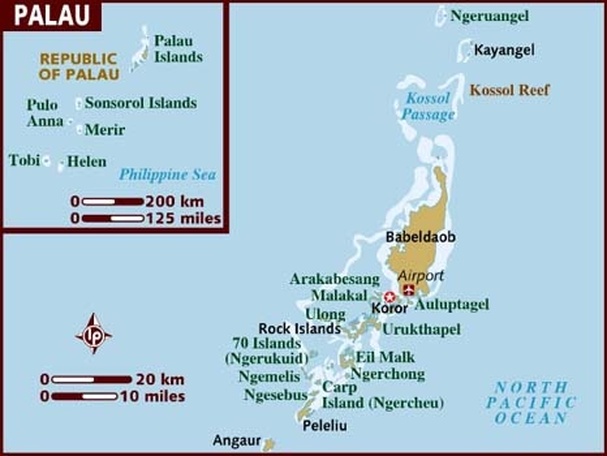Territorial & Freely Associated Oral Health Programs
Republic of Palau

Geography: Palau is the westernmost of the Micronesian islands sitting just 528 miles east of the Philippines and roughly 4,500 miles west of Honolulu. Palau consists of an archipelago of more than 300 islands and encompasses 196 square miles of land area including rock islands, equivalent to roughly 2.5 times the size of Washington, D.C. Moreover, Palau covers a sea area extending over 237,850 square miles. Geologically Palau has high, mountainous islands (i.e., largest island, Babelthuap) to low coral islands (i.e., Peleliu), usually fringed by large barrier reefs.
Government: The Palau government is comprised of 16 States including Aimeliik, Airai, Anguar, Hatobei, Kayangel, Koror, Melekeok, Ngaraard, Ngardmau Ngatpang, Ngchesar, Ngerchelong, Ngeremlengui, Ngiwal, Peleliu, and Sonsorol. Palau emerged from its UN trust territory status to become an independent republic in 1994, making it one of the youngest nations in the world.
Health Services: Palau has a government-owned Ministry of Health (MOH), comprised of the Belau National Hospital (129-bed acute care hospital), Dental Department, Behavioral Health Department, Department of Public Health, and a Community Health Center with satellite sites located roughly 30 minutes apart throughout Palau except for the Southwest outer islands. There are 5 private medical, eye and dental clinics.
Demography: Palau population is multi-ethnic composed of roughly 70% Palauans, 15% Filipinos, 5% Chinese, and a mix of others comprising the other 10%. English and Palauan are the primary spoken languages, and the 2017 est. per capita income is $16,200 per year with a national literacy rate 92%. The percent of population below 100% federal poverty level (FPL) is 58.7%. The youth and elderly dependency ratio are 0.28 and 0.10 respectively. In 2005, the percent of population below 100% FPL was 59.2. The average birth rate is 11.3 births per 1000 population with an average life expectancy at birth of 73.4 years. From 2011-15, infant mortality rate ranged from a low of 4.0 per 1000 live births in 2011 to a high of 16.8 per 1000 live births in 2015. The leading causes of death are all related non-communicable diseases (NCD) including coronary heart disease (CHD)/stroke (34%), diabetes mellitus (14%), and cancer (21%).
*Information on the USAPI provided by PIHOA in 2019 and adapted for the ASTDD Needs Assessment Project and this webpage



